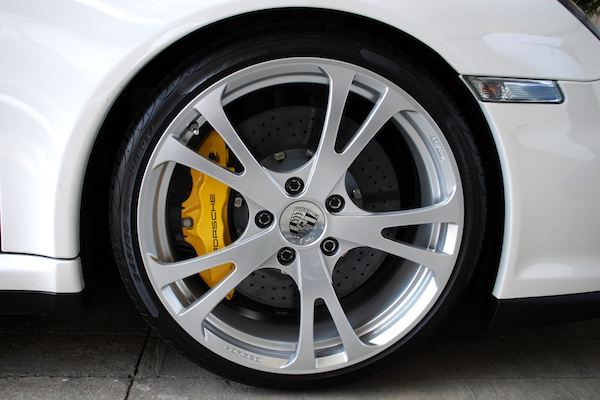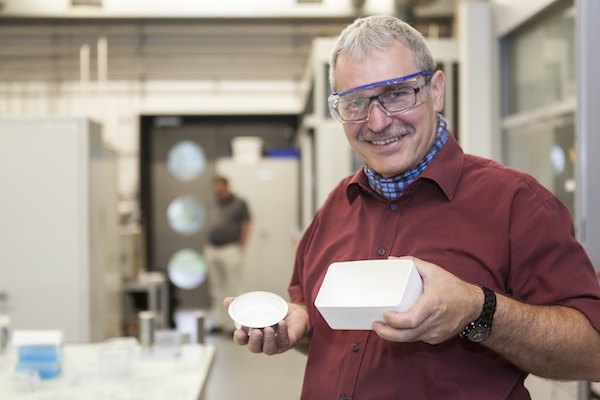
[Image above] Ceramic brakes are already in place in high-performance cars—like Porsches, where they can be quickly recognized by their characteristic yellow calipers—but will they find a home in more affordable options, too? Credit: Karma Motorsports; Flickr CC BY-NC-ND 2.0
Automobile brakes are like pavement markings—vital to the safety of every journey, yet hardly worth a ponder by the millions of people that drive the roads every day.
Think about how much you take your brakes for granted—you just expect them to work every time you approach a red light, stop sign, traffic jam, or that idiot’s bumper in front of you.
So it’s a good thing that most of the time, they work.
Though some may say that if it ain’t broke, don’t fix it, the push towards automobile lightweighting means that something has to change to shed some pounds from the heavy cast iron that make up most of our cars’ disc brake systems.
The best material for the job? Although we may be biased, the durability, heat and corrosion resistance, and light weight of ceramic materials make them well-suited for the job.
Carbon ceramic brakes are already used to slow down super fast (and gorgeous) cars like Aston Martins, Paganis, Lambos, Porsches, and Ferraris. But with high performance and high potential speeds comes another high—price.
Ceramic brakes as an add-on option to a Porsche 911 Carrera (which, at just $84,000 is an “affordable option” in the world of pretty cars) will set you back an additional $8,500. So while maybe worthy of a splurge, ceramic brakes are hardly a viable option for most of us.
You may not have to pine for the luxe life much longer, however. Researchers at Switzerland’s Empa research institute are aiming to bring ceramic brakes to the masses with an affordable option that can be installed on compact cars.
The team, which consists of Empa, Politecnico di Torino, Spanish brake manufacturer Fagor Ederlan, Liechtenstein soldering specialists Listemann AG, and the Fiat research center C.R.F., is working together to develop a product that can be quickly manufactured in large quantities and at low cost and that can perform at least as well as cast iron brakes—which is no trivial task.

Empa ceramics specialist Jakob Kübler develops the crucial part of the new disk brakes in his lab. Credit: Empa
To make the high-performance brakes masstige, however, the team is looking to replace the cast iron of traditional disc brakes with lightweight aluminum, rather than a completely ceramic body. That light aluminum will then be coated with a ceramic layer to protect the much-too-malleable metal from the friction, heat, and wear of braking.
“First of all, we had to find a low-priced ceramic material that is a good heat conductor and can also be processed easily,” says ceramics specialist Jacob Kübler in an Empa press release. The press release continues, “This rules out zirconium oxide as it insulates too strongly. And silicon carbide conducts heat well but breaks too easily, which leaves only one material: aluminum oxide.”
Using aluminum oxide, the team fabricated a ceramic laminate, just 2 mm thick, and then stacked of layers of the material 15 deep. With each layer, “silicon carbide is added to the aluminum oxide layers to increase the heat conductivity, along with a cover to regulate wear and tear, and an adherent layer to enable the ceramics to be soldered to the aluminum surface,” states the press release. “Every layer is blended with water to make a sludge, which is then applied to a synthetic film. Finally, the layers are compressed, the synthetic material in-between burned out and the different layers joined and condensed at several hundred degrees.”
Rather than applying the laminate in a single coating, the researchers are tiling the ceramic layer to the aluminum body like bathroom tiles. This configuration allows room for the aluminum’s expansion, which it does three to four times that of the ceramic.
Soldering the ceramic tiles is also a tricky process, however, because of aluminum’s rather dainty melting temperature of 700 degrees.
Because of these challenges, the team is currently testing different ceramic compositions to get just the right mix of properties, according to the release.
The team anticipates developing a prototype to begin testing by April 2015. According to the release, “If it passes, it will be used to develop a serial component over the next few years, which will give European cars a head start on the global market.”
Others have previously tried to offer ceramic brakes en masse, so we’ll have to keep tabs on this project as it progresses. But, if successful, and combined with other lightweighting advances like Audi’s new glass fiber suspension springs, tomorrow’s cars could a lot lighter, more high-tech, and—most importantly—energy efficient.
